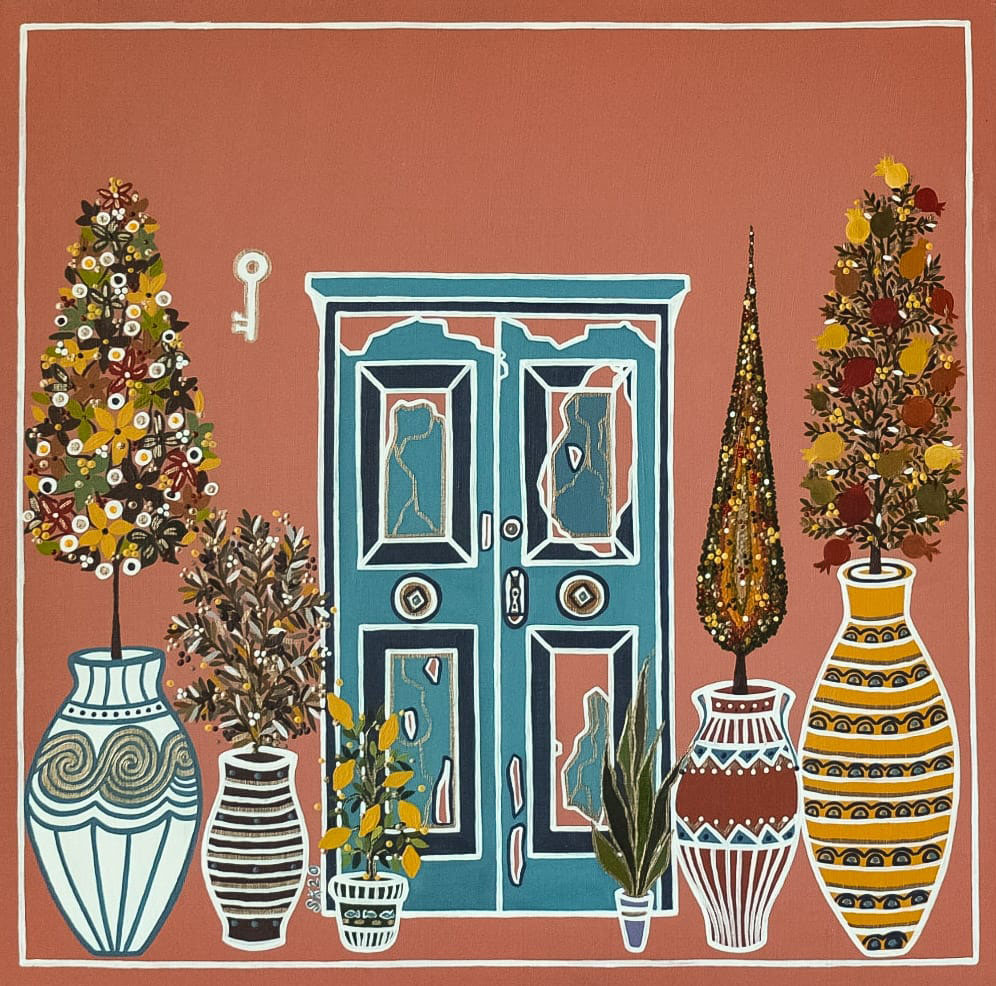- Year 2020
- Media Wooden panel, acrylic paint, golden metallic gilding paste
- Dimensions 50 х 50 сm
- Availability This painting is available for purchase. Price on request. Please don't hesitate to contact me.
- View more GALLERY
Door to the Mediterranean
“DOOR TO THE MEDITERRANEAN” is a natural reflection in the direction of the “Windows, Doors and Bridges” cycle of paintings. It contains one of the components of the cycle – the door.
A door is a symbol deeply ingrained into our psyche depicting the ideas of passage of boundaries or their closure. It represents the entry from one space or time to another, a threshold, a metamorphosis, a potential opportunity or a new beginning. However, it can also be seen as a boundary, barrier or keeper of a secret. Sometimes gaining access may be as simple as turning the handle, but at other times a door is locked and presents us with a choice to either try to enter peacefully or surmount it forcibly. We may need to knock or ring the bell and negotiate with the guardian of the door or submit a password which will secure our passage. This theme recurs in countless stories, literary works, fairytales and myths.
This particular door is typical in the countries around the Mediterranean. Why the Mediterranean, you would ask? It is a place I consider very dear to me. I love it because of the warm sea water, the tiny cities and villages, scattered like beehives along its shores, the numerous islands and islets dotting its map, the people there – who are better natured than those living inland due to their tough fate; also – because of the ghostly sunrises and golden sunsets and generally because one can see and feel life’s vibrancy along these coasts. While oceans are characterized with long and far away distances, the Mediterranean is a sea of proximity and neighborhood, especially in its Eastern part. This is one of the regions in which numerous trading and transportation routes have historically intersected trajectories: those of wine and olive oil, salt, wheat and spices, silk and amber, knowledge and science. Well…there was another road passing close to the Mediterranean – the road of war. The Eastern Mediterranean was and still is one of the crossing points between East and West. It was conquered, divided, appropriated and liberated by various states, peoples and religions. All of them left their marks on its appearance, history, economics, culture and traditions.
Usually the doors I have photographed in the Eastern Mediterranean (which motivated me to begin the “Doors” topic in my work) have not been all closed. On the contrary – most were widely open – inviting me to peek inside and get a quick glimpse of life in these regions, a snapshot of what the people there are like. I believe that the reason why most were widely open lies in the predominant inherent lack of solitude, quiet and loneliness in the Mediterranean.
The people in the Mediterranean have mostly lived together, in close daily contact with each other, sharing all moments of life and talking a lot about them, discussing them loudly and energetically. “Social distance” has never been practiced in these regions for whatever reasons. Neighbours have always kept their doors open to each other. When it rarely happened the outer doors facing the streets to be closed, inside between the neighbors’ houses and courtyards there were always internal small doors which gave them access to one another, without the external world seeing this. Thus, they could always reach out to one another even behind “closed doors”.
In this particular painting of mine, however, the door is closed. The reason was once more connected to the ongoing situation most of us are undergoing in relation to lockdowns. During the months of isolation most of us stayed behind closed doors leaving the beauty of nature, sunlight and rapid movement outside. Communication with family and friends was reduced to online and telephone exchange. We were forced to turn inwards and to possibly inventory and reevaluate our inner world. This process has a multitude of results, some good, some not so good.
In front of the door one can see the typical for the Mediterranean vessels – baked clay jars and amphorae in which wine, spices, olive oil and other liquids were kept and transported. Some of the plants in these vessels are also symbolic: the olive tree, the Cyprus tree, the pomegranate, the lemon, the sansevieria plant (which goes by the name of “mother in law’s tongue” in some countries in the region), the ilex and others.
